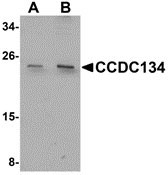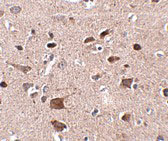CCDC134 Antibody
- SPECIFICATION
- CITATIONS
- PROTOCOLS
- BACKGROUND

Application
| WB, IHC-P, IF, E |
|---|---|
| Primary Accession | Q9H6E4 |
| Other Accession | NP_079097, 13376216 |
| Reactivity | Human, Mouse, Rat |
| Host | Rabbit |
| Clonality | Polyclonal |
| Isotype | IgG |
| Calculated MW | 26561 Da |
| Application Notes | CCDC134 antibody can be used for detection of CCDC134 by Western blot at 1 - 2 µg/mL. Antibody can also be used for immunohistochemistry starting at 2.5 µg/mL. For immunofluorescence start at 20 µg/mL. |
| Gene ID | 79879 |
|---|---|
| Target/Specificity | CCDC134; |
| Reconstitution & Storage | CCDC134 antibody can be stored at 4℃ for three months and -20℃, stable for up to one year. As with all antibodies care should be taken to avoid repeated freeze thaw cycles. Antibodies should not be exposed to prolonged high temperatures. |
| Precautions | CCDC134 Antibody is for research use only and not for use in diagnostic or therapeutic procedures. |
| Name | CCDC134 |
|---|---|
| Function | In extracellular secreted form, promotes proliferation and activation of CD8(+) T cells, suggesting a cytokine-like function (PubMed:25125657). Enhances cytotoxic anti-tumor activity of CD8(+) T cells (PubMed:25125657). May inhibit ERK and JNK signaling activity (PubMed:18087676, PubMed:23070808). May suppress cell migration and invasion activity, via its effects on ERK and JNK signaling (PubMed:23070808). Has a critical role in the regulation of osteogenesis and bone development (PubMed:32181939). |
| Cellular Location | Nucleus. Cytoplasm. Secreted Endoplasmic reticulum. Note=Accumulates in the nucleus in response to UV irradiation (PubMed:22644376) |
| Tissue Location | Expressed in cervical gland, cervical squamous epithelium, endometrium, stomach, kidney distal convoluted tubule, spermatogenic cells in testis, mammary gland, liver and striated muscle (at protein level) (PubMed:18087676, PubMed:23070808). Also detected in placenta (PubMed:18087676). Highest expression in testis relative to other tissues (PubMed:18087676). Detected in T cells and dendritic cells; highly expressed in activated CD8(+) T cells, and also expressed at lower levels in CD4(+) T cells (PubMed:25125657) |

Thousands of laboratories across the world have published research that depended on the performance of antibodies from Abcepta to advance their research. Check out links to articles that cite our products in major peer-reviewed journals, organized by research category.
info@abcepta.com, and receive a free "I Love Antibodies" mug.
Provided below are standard protocols that you may find useful for product applications.
Background
CCDC134 Antibody: The coiled-coil domain is a common protein motif that is often involved in protein oligomerization and is found in proteins such as transcription factors and intermediate filaments. One such protein is CCDC134, a recently identified secretory protein that has been found to inhibit the transcriptional activity of the Elk1 protein. Overexpression CCDC134 also inhibited the phosphorylation of Erk and JNK/SAPK but not p38 MAPK, while specific siRNA against CCDC134 activated Elk1 transcriptional activity and the phosphorylation of Erk and JNK/SAPK, suggesting a potential inhibiting role of CCDC134 in MAPK-mediated Elk1 transcription. CCDC134 is widely expressing in normal adult tissues, tumors, and cell lines.
References
Steinmetz MO, Jelesarov I, Matousek WM, et al. Molecular basis of coiled-coil formation. Proc. Natl. Acad. Sci. USA2007; 104:7062-7.
Huang J, Shi T, Ma T, et al. CCDC134, a novel secretory protein, inhibits activation of ERK and JNK, but not p38 MAPK. Cell. Mol. Life Sci.2008; 65:338-49.
If you have used an Abcepta product and would like to share how it has performed, please click on the "Submit Review" button and provide the requested information. Our staff will examine and post your review and contact you if needed.
If you have any additional inquiries please email technical services at tech@abcepta.com.













 Foundational characteristics of cancer include proliferation, angiogenesis, migration, evasion of apoptosis, and cellular immortality. Find key markers for these cellular processes and antibodies to detect them.
Foundational characteristics of cancer include proliferation, angiogenesis, migration, evasion of apoptosis, and cellular immortality. Find key markers for these cellular processes and antibodies to detect them. The SUMOplot™ Analysis Program predicts and scores sumoylation sites in your protein. SUMOylation is a post-translational modification involved in various cellular processes, such as nuclear-cytosolic transport, transcriptional regulation, apoptosis, protein stability, response to stress, and progression through the cell cycle.
The SUMOplot™ Analysis Program predicts and scores sumoylation sites in your protein. SUMOylation is a post-translational modification involved in various cellular processes, such as nuclear-cytosolic transport, transcriptional regulation, apoptosis, protein stability, response to stress, and progression through the cell cycle. The Autophagy Receptor Motif Plotter predicts and scores autophagy receptor binding sites in your protein. Identifying proteins connected to this pathway is critical to understanding the role of autophagy in physiological as well as pathological processes such as development, differentiation, neurodegenerative diseases, stress, infection, and cancer.
The Autophagy Receptor Motif Plotter predicts and scores autophagy receptor binding sites in your protein. Identifying proteins connected to this pathway is critical to understanding the role of autophagy in physiological as well as pathological processes such as development, differentiation, neurodegenerative diseases, stress, infection, and cancer.




